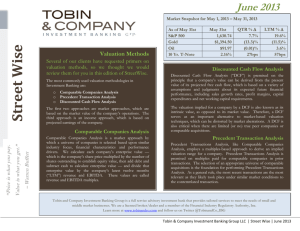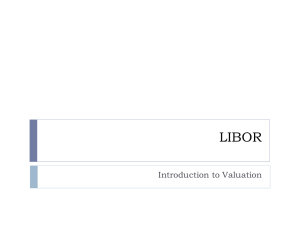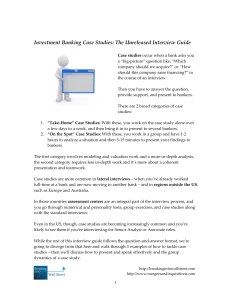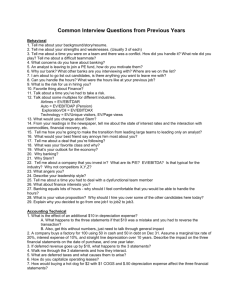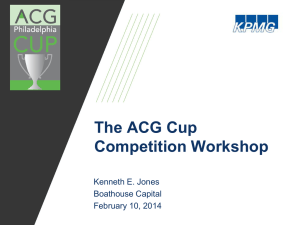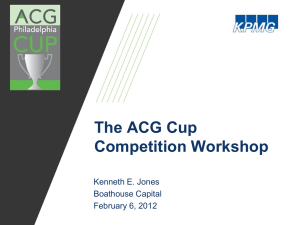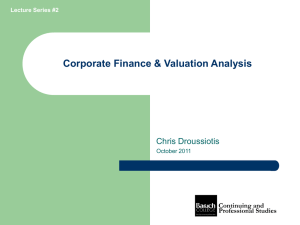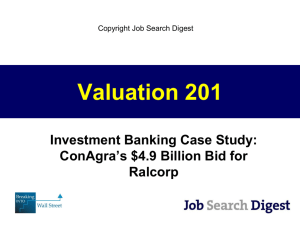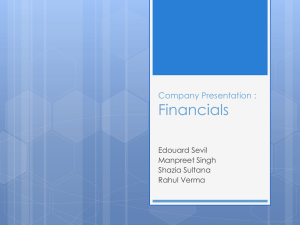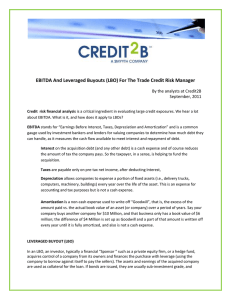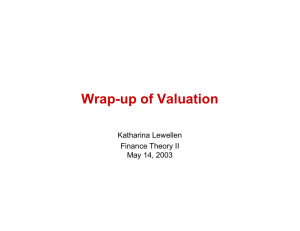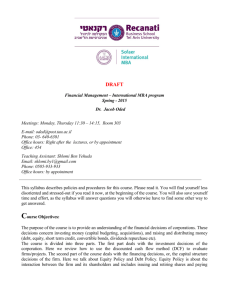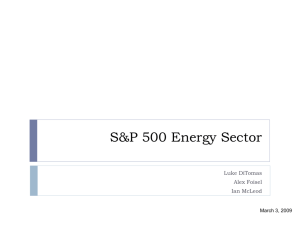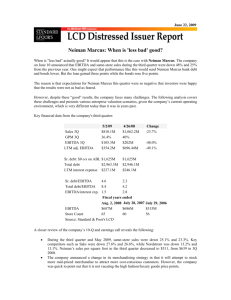Interview Questions
advertisement
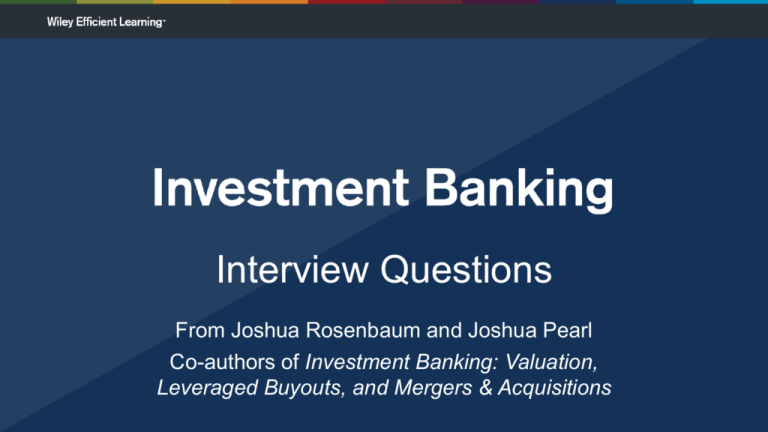
Interview Questions From Joshua Rosenbaum and Joshua Pearl Co-authors of Investment Banking: Valuation, Leveraged Buyouts, and Mergers & Acquisitions How do the three primary financial statements link together? Links between the Income Statement, Balance Sheet, and Cash Flow Statement include: • Net income from the Income Statement flows into the Cash Flow Statement as the beginning line item under Operating Activities, and it also increases Retained Earnings on the Balance Sheet • Periodic changes to current assets and current liabilities on the Balance Sheet link to the Cash Flow Statement under Operating Activities • The beginning cash balance on the Balance Sheet links to the Cash Flow Statement • The ending cash balance on the Cash Flow Statement becomes the ending cash balance on the Balance Sheet • New debt issuance (as well as repayment) shows up on the Cash Flow Statement as well as the Balance Sheet • Depreciation on the Income Statement decreases property, plant and equipment (PPE) on the Balance Sheet and also is added back to Net Income in the Operative Activities Section of the Cash Flow Statement • Capex under Operating Activities in the Cash Flow Statement increased PP&E on the Balance Sheet How is enterprise value (EV) calculated? What happens to EV if the company raises additional debt? To calculate enterprise value, begin with a company's market capitalization (or implied equity value), add debt, preferred stock, and non-controlling interest, and then subtract cash and cash equivalents. If a company raises additional debt that is held on the balance sheet as cash, its enterprise value remains constant as the new debt is offset by the increase in cash. Net debt remains the same. What are the primary valuation methodologies? The primary valuation methodologies are: • Comparable companies analysis • Precedent transactions analysis • Discounted cash flow analysis • Leveraged buyout analysis Walk through a DCF valuation. A DCF seeks to value a company based on the present value of its projected free cash flow in perpetuity. It is common practice to project a company's FCF for a period of at least five years or longer in order to capture a full business cycle or steady state level. The first step, therefore, is to develop a defensible set of five-year free cash flow projections, starting with sales and then cascading down to EBITDA and FCF. However, given the inherent difficulties in accurately projecting a company’s financial performance over an extended period of time (and through various business and economic cycles), a terminal value is used to capture the remaining value of the target beyond the projection period. The terminal value is determined using either an exit multiple or perpetuity growth rate on the company's steady state EBITDA or FCF. Next, the annual projected FCFs and terminal value are discounted to their present value using a weighted average cost of capital and then summed to produce an implied enterprise value. After subtracting net debt, you arrive at an implied equity value. The major inputs, including growth rate and margin assumptions that drive the annual FCF projections, exit multiple or perpetuity growth rates, and WACC assumptions can then be sensitized to produce an implied valuation range. What are the advantages of DCF analysis? • Cash flow-based; not reliant on using multiples-based methodologies • Market independent; more insulated from market aberrations • Self-sufficient; does not rely entirely upon truly comparable companies or transactions • Flexible; can run multiple financial performance scenarios What are the disadvantages of DCF analysis? • Dependence on financial projections • Sensitivity to assumptions; “garbage in, garbage out” • Dependence on terminal value; can represent as much as 75% or more of total valuation • Assumes constant capital structure What are the disadvantages of DCF analysis? • Dependence on financial projections • Sensitivity to assumptions; “garbage in, garbage out” • Dependence on terminal value; can represent as much as 75% or more of total valuation • Assumes constant capital structure What are the key differences between comparable companies analysis and precedent transactions analysis? First and foremost, comps are based on current trading multiples of public peer companies. Precedent transactions analysis is based on the multiples at which peer companies have been acquired, which typically include a control premium. Technical differences include: • Time period: precedent transactions analysis by definition have occurred in the past while comparable companies analysis is based on current public market multiples • Availability of information: since comparable companies analysis is based on public companies, you have a wealth of information to perform the analysis. For precedent transaction analysis, it might be difficult to find information for certain transactions, especially for private deals • Synergies/control premium: Recent transaction comps tend to provide a higher multiple range than trading comps for two principal reasons o o Buyers generally pay a “control premium” when purchasing another company Strategic buyers often have the opportunity to realize synergies, which supports the ability to pay higher purchase prices What is an LBO? An LBO is the acquisition of a company using debt to finance a large portion of the purchase price, typically 60% to 70% of the financing structure. The remaining portion of the purchase price is funded with a 30% to 40% equity contribution by the acquiring private equity firm. The PE firm’s ultimate goal is to realize a 20%+ annualized return through an investment exit within five to seven years, typically via a sale or IPO of the target. What are the common characteristic s of a strong LBO candidate? • Strong cash flow generation • Leading and defensible market positions • Growth opportunities • Efficiency enhancement opportunities • Low capex requirements • Strong asset base • Proven management team Calculate fully diluted shares given a company with 1 million basic shares, a current share price of $20, and 100,000 options outstanding at an exercise price of $5. Because the $20 share price is greater than the $5 exercise price, the options are inthe-money. Using the Treasury Stock Method, 100,000 in-the-money options are purchased at $5 a piece for $500,000. The $500,000 divided by $20 = 25,000 shares repurchased. The 25,000 subtracted from the 100,000 options leaves 75,000 net new shares. And, combined with the 1 million basic shares sums to 1,075,000 fully diluted shares. How could a company with positive EBITDA go bankrupt? • Capex is not reflected in EBITDA, but when a company purchases a machine for instance, it’s a large cash outlay • Interest Expense: By definition, EBITDA is before interest expense. If a company has low EBITDA but a large amount of debt and thus a large interest expense, it might not be able to afford its payments • One-time charges: The cash outlays for a large restructuring or litigation charge can affect the cash flow of a company

